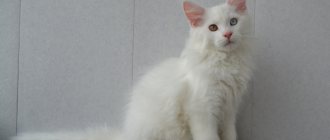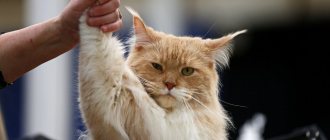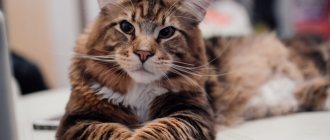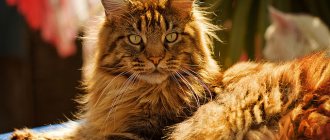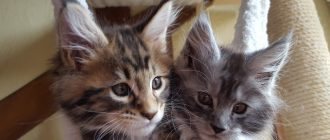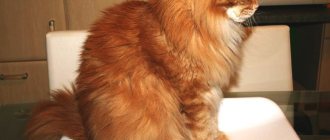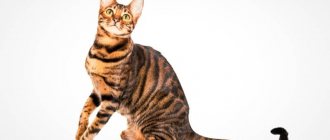The debate about the beauty of animals of a certain color is hardly relevant, because some people are in love with charming white cats, while other owners love the creamy shades of their pets’ fur coats. But, perhaps, almost everyone will agree that the magnificent black Maine Coon looks truly impressive and even mystical. However, in some cases, describing such animals as simply black is not enough. It turns out that this color can have certain shades.
Description and color varieties of black Maine Coon
The classic color scheme of Maine Coon cats is the uniform dark color or the so-called black solid (translated from English as “solid”). The coat of such tailed animals is originally black and has no spots or stripes on the surface.
But sometimes patterns or lines appear on the Maine Coon's shiny coat. The latter are clearly visible on the animal’s face and neck.
Depending on the fur patterns, the following varieties of black Maine Coons are distinguished:
- Brindle - vertical stripes cover the fur on the cats body, as well as the paws and tail.
- Marble. The dark lines on the sides of the Maine Coon suggest streaks on smooth black marble. Dark spots are traced inside such rings.
- Spotted. There are visible stripes on the cat's body.
Sometimes white fragments are woven into the overall picture of a black celebration.
Such cats are usually called black and white, but the location of the white areas has its own patterns that determine the name of the color of the black Maine:
- The white medallion is a light spot, like a precious piece of jewelry, that takes pride of place on the cat’s dark chest.
- White gloves - the light shade affected only the paws.
- A white tuxedo is a characteristic light “front” on the chest of a mustachioed pet; it can be combined with white paws.
- Bicolor is a combination of white and black shades in a 50/50 ratio.
- Harlequin - the main color of the fur coat is white, with small splashes of black spots.
- Van - the head and tail of the quadruped remain dark, the remaining areas are white.
- Black smoke - the hairs have a white tint at the roots, gradually turning black (closer to the tips). Usually there are no spots or stripes on the fur coats of such animals.
“Black Smoke” Maine Coons are divided into several varieties of shades:
- chinchilla – 1/8 of the hairs are black, the rest are white at the roots;
- actually smoky - the ratio of hairs, black and white - 50/50;
- shaded - the hairs are 1/4 black, the rest are white at the root.
Character and habits characteristic of the breed
Black Maine Coons have not only a memorable appearance, but also a special character.
In the cat's soul of these charming giants, even mature and respectable ones, live small playful kittens. The good-natured disposition and curiosity of Maine Coons make them everyone's favorites. Playful and playful, these animals, due to their gigantic size, often find themselves in humorous situations.
Many people are afraid to come into contact with Maine Coons, believing that animals of this size are capable of causing, if not fatal, injuries in the form of scratches or noticeable bites. However, these cats are very affectionate and friendly and will never resort to using their claws without special reasons.
Maines adore their family, but can be wary of strangers. The furry beauties' favorite pastime is to take a nap in the sun, including in the fresh air. But if the owner is in the mood to play with the pet, the giants will never miss such a wonderful opportunity to frolic.
Maine Coons do not tolerate loneliness well. Therefore, people who are always busy and are rarely at home should not have animals.
Features of care and maintenance
When purchasing a Maine Coon kitten, you should pay special attention to the corner of the new family member.
It can be equipped with the following items:
- Bed. It must certainly be spacious, taking into account that the pet will grow. You can purchase a ready-made sample at a pet store or build it yourself using fabric, foam rubber and padding polyester.
- Tray. It should also be spacious enough. You should not choose a product with high sides for your kitten.
- Filler. To help your baby adapt faster to a new place, you should ask the breeder what type of litter was used in the nursery.
- Scratching post. Must be commensurate with the size of the animal.
- Toys. Only safe soft samples (balls, mice) are suitable. You should not offer your pet objects to play with that have parts that can come off during the fun - beads, buttons, etc.
- Bowls. Glass, ceramic or steel containers are better suited.
As the pet grows, the owner should consider a number of recommendations for keeping furry giants:
- Cats of this breed need walks in the fresh air. In the fenced area of a private house, they usually walk calmly, without trying to escape outside the home. The owner of a cat living in an apartment should think about periodically walking the pet. A collar and leash are suitable for this purpose.
- Grooming. The luxurious mane of the Maine needs to be combed 1-2 times a week, and daily during the molting period. Giants need to be bathed about 4 times a year, using shampoo for long-haired cats.
- Additional care procedures. You should systematically check the condition of the Maine Coon's teeth (clean with a special brush and paste), ears (remove wax with cotton swabs and a special product) and eyes (wipe with turundas moistened with boiled water).
- Veterinarian examinations. Of course, cats need to have all recommended vaccinations. All alarming symptoms (intestinal dysfunction, apathy, hyperthermia) should be noted and promptly contact a specialist for their elimination.
- Feeding. Both industrial and natural are allowed. Ready-made feeds should be selected taking into account the age and weight of the animal. It is best to choose top-class products designed specifically for large pets. A natural diet in no way involves food from the master's table. The menu should include boiled meat (daily - chicken, turkey, rabbit), vegetables (beets, broccoli, zucchini), herbs (dill, lettuce, parsley). It is acceptable to treat your pet to sea fish (no more than 2 times a week). In addition to these products, you can introduce cereals and dairy products into the Maine Coon's diet. Animals should be fed twice a day, avoiding overeating. Cats are offered filtered or boiled water, changing 1-2 times a day.
What to name a black Maine Coon kitten?
Of course, there are absolutely no restrictions in choosing a nickname for the giant cat. However, some owners prefer to choose a name for their pet based on its charcoal color.
In such cases, you should pay attention to the following options:
- Black, Blackie;
- Dark;
- Noir;
- Secret;
- Coal;
- Schwartz;
- Chernysh;
- Blade;
- Darth, Vader;
- Chernomor;
- Dracula;
- Bagheera;
- Anubis.
Magnificent black Maine Coons are the pride and adornment of the family. Despite their impressive size, cats are affectionate, trusting and very intelligent. Provided it is well maintained, the pet will always delight its owners with excellent health and a playful mood.
Tags: pets, animals, Cats, Maine Coon
- Related Posts
- Ammonia in the garden and vegetable garden. Application
- Russian Siberian cat: description and characteristics of the breed
- What is the most effective remedy for the Colorado potato beetle?
« Previous entry
Traditional Maine Coon colors: photos and descriptions
There are several types of coat patterns called tabby.
They all have their own patterns. Tabby was inherited from the wild ancestors of modern domestic Maine Coons. Their distinctive feature is the letter “M”, which is visible in the area of the cat’s forehead and eyes with light or dark lines. There are three types of tabby:
- Tigers. The stripes on the body are parallel to each other.
- Spotted. There are spots of dark and light shades on the sides.
- Classic. Similar to the pattern of marble.
There is also a fourth type - ticked, but it is not typical for this breed. It is usually found in the Abyssinian breed and other oriental cats. It may appear in isolated coon individuals.
Often there are uniform colors in the same range; they are called solid or in the English version - solid (uniform). In this case, the tabby can be almost invisible. Often found in cats that are black in color. The darker the cat, the weaker the pattern of its coat appears. Tabby is especially pronounced in cats with fur of red (red) shades. Solids can be in the following palette:
- black;
- cream;
- red;
- smoky;
- blue.
Smoky gray and blue are of particular interest to Maine Coon breeders, as they are very rare for representatives of this breed. The gallery below shows photos of popular colors.
Maine Coon color calculator
To understand what color will result from crossing animals, breeders use a calculator table. With its help, you can predict with a very high probability what color the offspring of a thoroughbred couple will inherit.
How the coat colors of Maine Coon offspring interbreed.
This is, of course, not a guaranteed result, as it is impossible to calculate the exact genetic combination a kitten will inherit. From time to time, extremely interesting representatives of coons are born, having, for example, tortoiseshell tones, which is very rare for this breed. It has been noticed that most of these individuals are female.
Gray Maine Coon
Gray or blue colors are considered rare for this breed.
An even color of blue shades is a rare occurrence. A smoky shade is usually found. These cats look special; their color gives them their aristocratic charm. If a cat is exactly like this, it means that the gene responsible for the presence of a pattern on the body has been completely suppressed.
Blue tones are specially developed through selective breeding. This takes a lot of time and effort from breeders. The letter “A” is placed in the passport of such a kuna. If the cat has two-color fur, the code “03” is added to the letter designation.
How to understand color coding
To make it easier to identify a specific Maine Coon individual, tables have been compiled. They are composed as a coding, written in numbers and letters. This code system for identifying a white, black or red cat, as well as rarer colors (tabby, chocolate, tortoiseshell, tricolor) is called EMS.
To understand this encoding, it is enough to know which symbol means which color:
- N – black;
- A – blue solid;
- D – red Maine Coon (red kitten);
- F – Maine Coon tortoiseshell;
- W – white kitten;
- G – smoke or blue Maine Coon.
Additionally, if the Maine Coon is silver or silver merle, an extra "S" is added to the first letter.
A white Maine Coon with blue eyes will be identified not only by a letter, but also by a number. If such a cat has colored spots on the tail and in the shoulder area, next to the letter there will be “01”. If 50% of the coat is devoid of pigment, you will see “03” in the coding. If there is a small amount of white (on the paws and in the chest area) it is coded “09”. When designated "21" be aware that this type refers to the Maine Coon tabby color.
The number “25” denotes ticked color – this is one of the rarest varieties of such cats. Characterized by the absolute absence of tabby. However, each individual hair of such representatives of the breed has several colored stripes, thanks to which the Maine Coon cat looks very impressive.
Similar article: What to feed a kitten and an adult Bengal cat
The rarest and most expensive Maine Coon colors
Each breed has rare colors that are not often seen. Maine Coons are no exception. This breed has its own rare shades:
- Brown with spots. These kittens have a color similar to autumn foliage.
- Creamy blue. Looks like tortoiseshell with rare pastel shades.
- Chintz. This is a unique coloring for coons. The base is red, diluted with black tones with white splashes.
- Watered down chintz. There are cream-colored spots on a white background, and blue colors have a solid coloring.
- Spotted with white spots.
Such colors are not typical for coons and are rare.
Smoky
Such cats can be black or blue. The intensity of the haze determines the subspecies:
| Name | Description |
| Chinchilla | Only the tip of the hair is pigmented |
| Shaded | color has a quarter of the hair |
| Smoke | Only the root of the hair is colored white, the main part has black or blue pigments |
| True smoke | Half of the hair has pigmentation |
| Silver | the hair is white at the root, the rest is light silver |
| Cream | at birth, the coat is uniform in color, but gradually becomes unevenly pigmented |
| Classic wild | brindle, marbled black, spotted |
Smoky cats are characterized by white roots. Gray is usually found in monochromatic animals.
Chocolate
The wool is colored brown, warm, rich. The presence of inclusions of other shades or patterns is not allowed. The hairs have an even distribution of pigment. Unlike red tones, it is darker and deeper. Quite rare in breeding. The paw pads and nose also have brown tones.
Classic wild
This color suggests the presence of a pattern on the animal's fur. They can be of different types:
- brindle;
- marble black;
- spotted.
These are the main colors of coons that were common among their wild ancestors.
Peach
These cats have similar features to their cream counterparts. These can be yellow, orange shades characteristic of tabby coons.
Black
Black monochromatic coloring is extremely rare for this breed.
Each black coon has a different color depth and saturation, so it is impossible to find two identical black cats. Usually, this color hides the pattern on the coat. In small kittens it can be difficult to see, but as they grow older it is completely hidden. The cat becomes completely monochrome. An animal with black fur looks regal, luxurious, reminiscent of a majestic panther in appearance.
Black and white
Cats with this coloration have different proportions of these colors:
- Black with white spots. There are several small spots of white on the fur.
- White medallion. A white spot is located on the chest of the animal, reminiscent of decoration.
- White gloves. The cat has black and only white paws of the animal.
- White tuxedo. There is a white shirtfront on the neck, and the paws are also white.
- Bicolor. Black and white in a 1/1 ratio.
- Harlequin. The color is predominantly white with a few black spots.
- Wang. The head and tail are painted black. The rest of the body is white.
What is the danger of white color
White Coons have a predisposition to complete deafness.
It is found in this color much more often than in animals with a different shade of fur. However, there is no need to be upset by this fact. Deaf individuals feel great.
They live well in the house, and are oriented to the area no worse than healthy ones. Their hearing loss is compensated by vision and a keen sense of smell. People who do not know about cat deafness will not guess about it.
Cream
This shade is obtained by lightening the red. The animals are colored in shades similar to raw ginger. When crossing, individuals with genetically weakly expressed pigment in the pedigree are preferred. However, theoretically, even Black Solid Maine Coons can produce cream-colored offspring.
Contents: how to care for a cat?
After the owners have brought the pet home, it is not recommended to carry out bathing procedures for several weeks in order to protect the animal from stress. You can only comb the coat using a hard specialized brush once a week. It is necessary to purchase a scratching post for your pet, making sure to pay attention to the strength and height of the product. After adaptation, it is important to bathe the animal. The adoption of water procedures should be carried out with shampoos and conditioners, after which the pet must be wiped dry with a warm terry towel. If there are fleas in your cat's fur, or to prevent their appearance, you should use specialized medications. Experts do not recommend bathing Maine Coons with black smoke before and after vaccination and if the cat has had any illness. It is necessary to clean the eyes and ears as they become dirty with cotton pads or a soft cloth moistened with warm water.
Tortoiseshell
The tortoiseshell Maine Coon comes in two types – torby and torty.
The first type is a combination of red and black shades of wool, expressed in a dark brown color. The torti has a greater addition of red with dark cream. Of particular interest is the fact that tortoiseshell coloring is most often found in cats.
The probability of a male being born with this coloring is approximately 1 in 1000.
On such cats, markings of different sizes and shapes are more clearly visible. Based on the severity of these spots, several colors can be distinguished:
- calico;
- flap;
- chintz.
These cats are characterized by the presence of red shades of fur. The classic color, consisting of three colors, is obtained by mixing black and red. This makes the coat more variegated. There are also several tortoiseshell shades.
Scaly tortoiseshell
Reminiscent of fish scales, the order of spots on the body is checkerboard. These spots alternate in black and red tones and are unevenly distributed. Any one of the colors may predominate.
Calico and solid tortoiseshell (patchwork)
The spots of black and red color resemble flaps. They have defined boundaries and can overlap each other. If the wool has white patches, this color is called “tortoiseshell white” or calico. Red and black spots are solid in color and clearly visible on the animal’s body.
Patterned tortoiseshell
Multi-colored spots have a pronounced pattern. These may be spots or stripes, but marbled colors are also common. There may be small white spots. In this case, it is fashionable to say that the color is spotted tabby or tabby with white spots.
Marble colors
Can be cold or warm tones. The first has more gray tones, while the warm one is dominated by brown shades. These stains sparkle in the sun in a special way, which many people like. Such stains can be drawn in different ways - stripes, spots, contours. Such spots can be well defined, then they are more reminiscent of a tortoiseshell color. Marble coloring has more diffuse, blurred borders of spots.
Tabby
This type of coloring is present in all representatives of the Maine Coon breed, but may not be expressed in a bright form. This color is a genetic predisposition. A cat's hair has its own zoning or striping. The wild ancestors were tabbies, which was inherited by modern representatives. There are various options for this design.
Classic, spotted and brindle tabby
Characterized by wide stripes of a spiral shape. They are usually located on the sides of the animal, and can resemble marble stains. Spotted tabbies have intermittent stripes or spots of color throughout the animal's body. The brindle tabby is similar to the brindle coloring - vertical stripes along the entire length of the body.
Ticked Tabby
These cats have no stripes or spots at all. The fur has a peculiar pattern on the face, paws, and chest. Ticking is the distribution of pigment along the hair. The tip has a rich shade, gradually losing brightness towards its root.
Dangerous shining beauty
It is impossible to ignore such a serious health problem in white Maine Coons as deafness. This disease is traditionally inherited along with the W gene.
- About one in five white cats with eyes of any color are born deaf.
- In blue-eyed albinos this figure reaches a proportion of 4/5.
- If we compare white cats with different eyes, then 4 out of 10 animals have hearing problems.
Although scientists have not yet identified a separate gene for deafness, it has been proven that deaf parents consistently inherit this disease to their kittens.
Random color combination
Sometimes there are situations when the maine has a color that does not fit any of the color types. For this purpose, its own classification was created. These colors can be called:
- Brown tabby with spots. Such an animal has spots of red and brown.
- Blue spotted tabby. The cat in this case has cream and blue stripes on its body.
- Creamy blue. The spots are scattered in a chaotic manner throughout the body. This color is sometimes called a blue turtle.
- Creamy blue, white.
- Spotted tabby with white spots. The color is similar to the previous one, but there are inclusions of white spots.
Such combinations are also rare.
Bicolor or not bicolor?
The main color of the maine can be complemented by clearly defined white spots of different sizes. Some owners call any white-spotted cat “bicolor,” but this is not entirely true. White spots also have their own official names:
- “buttons” - small spots all over the body;
- “gloves” - white paw tips;
- “medallion” - a spot on the chest;
- “harlequin” - white background with large colored spots;
- "van" - predominantly white with color only on the head and tail;
- “tuxedo” (felinology does not formally use this definition, but it is widely used among cat owners) – white legs and chest, contrasting with the main color.
And bicolor is the official name of a color in which white and colored wool are present in a ratio of 50x50.
color black bicolor
color red bicolor
color blue bicolor
Unrecognized
Chocolate, gold, and lilac colors are not allowed at specialized exhibitions. Coons with Siamese coat color are also not recognized. There are patterns that are considered unrecognized for the Coons. These can be called:
- faun;
- cinnamon;
- point;
- sorrel;
- acromelanic color.
The coat color of Maine Coons is distinguished by a huge variety of colors and their combinations. The eyes of purebred animals must match the color of their fur. They can be blue (only pure white wool), green, yellow. White individuals may have different colored eyes (blue and green).
EMS color code
The International Association of Felinologists has developed a table that includes color options recognized by professional breeders. We need such a systematic collection for the convenience of making entries in the pedigree of the animal, bringing information about the breed to a single standard.
Unified table of coat colors according to EMS coding.
Thus, all colors not included in the standard coding are considered coat color defects. Individuals with unrecognized colors are not allowed at exhibitions and are not used in breeding.
However, they are suitable for home keeping in the same way as those with coat colors included in the table. Representatives of this breed have many genetically determined color options. Each Maine Coon is beautiful in its own way, no matter what color nature gave it.


